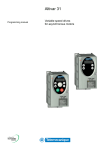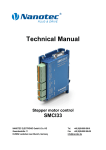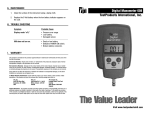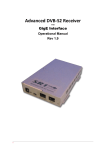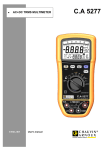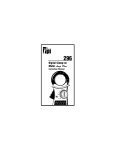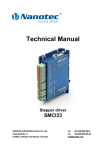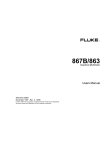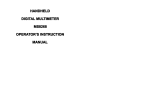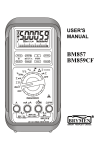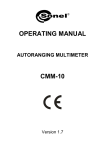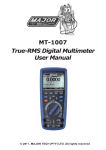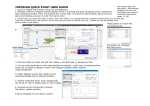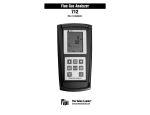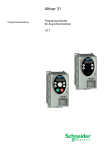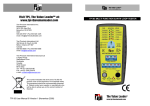Download User Manual - Temperature & Process Instruments, Inc.
Transcript
183 Digital Multimeter Instruction Manual A. INTRODUCTION TABLE OF CONTENTS page A. INTRODUCTION 1. Congratulations . . . . . . . . . . . . . . . . . . . . .3 2. Product Description . . . . . . . . . . . . . . . . . .3 3. EC Declaration of Conformity . . . . . . . . . . .4 B. SAFETY CONSIDERATIONS . . . . . . . . . . . . . . . .5 C. TECHNICAL DATA 1. Features and Benefits . . . . . . . . . . . . . . . . .7 2. Product Applications . . . . . . . . . . . . . . . . .8 3. Specifications . . . . . . . . . . . . . . . . . . . . . .9 D. MEASUREMENT TECHNIQUES 1. Controls and Functions . . . . . . . . . . . . . . . . . .12 a) Disable Auto Power Off . . . . . . . . . .13 b) Activating PC Communications . . . .13 2. Step by Step Procedures: a) Measuring DC Volts . . . . . . . . . . . . .15 b) Measuring AC Volts . . . . . . . . . . . . .17 c) Measuring DC Amps . . . . . . . . . . . .18 d) Measuring AC Amps . . . . . . . . . . . .20 e) Measuring Resistance . . . . . . . . . . .21 f) Measuring Diodes . . . . . . . . . . . . . .22 g) Continuity Buzzer . . . . . . . . . . . . . .23 h) Measuring Capacitance . . . . . . . . . .24 i) Measuring Frequency . . . . . . . . . . .25 j) Record Mode . . . . . . . . . . . . . . . . .26 k) Compare Mode . . . . . . . . . . . . . . . .27 l) Relative % Mode . . . . . . . . . . . . . . .28 m) Two-Hold System . . . . . . . . . . . . . .29 n) RS-232C Interface . . . . . . . . . . . . . .30 E. ACCESSORIES . . . . . . . . . . . . . . . . . . . . . . . .32 F. MAINTENANCE . . . . . . . . . . . . . . . . . . . . . . . .33 G. TROUBLE SHOOTING GUIDE . . . . . . . . . . . . . .34 2 1. Congratulations!! Thank you for purchasing a TPI Digital Multimeter. The Triple Display 183 is an innovative new concept in DMM design. The unique display enables you to view more than one event at a time. This eliminates the hassle of switching back and forth to review minimum, maximum or preset comparative values. The meter is also easy to use and built to last. The 183 is covered by a 3 Year Limited Warranty. 2. Product Description The 183 is a hand-held autoranging DMM. The backlit LCD can display three readings at one time. In addition to basic functions of ACV, DCV, ACA, DCA, , Diode Test and Continuity, the 183 measures Frequency (Hz) and Capacitance. The 183 also has RS232 output and software for recording information into a PC. The 183 also features: • REC Records Min/Max and Average readings during specified measurement intervals. Time reference can also be displayed to determine when the values were recorded. • COMP Compare actual reading to preset HI and LOW values for Pass/Fail testing of components. • HOLD Two-hold system automatically holds the previous stable reading when a new one is obtained. The 183 comes complete with the following accessories: Battery Rubber Boot Test Lead Set Instruction Manual 3 3. EC Declaration of Conformity This is to certify that model 183 conforms to the protection requirements of the council directive 89/336/EEC, in the approximation of laws of the member states relating to Electromagnetic compatibility and 73/23/EEC, The Low Voltage Directive by application of the following standards: EN 50081-1 EN 50082-1 EN61010-1 EN61010-2-031 1992 Emissions Standard 1992 Immunity Standard 1993 Safety Standard 1995 Safety Standard To ensure conformity with these standards, this instrument must be operated in accordance with the instructions and specifications given in this manual. CAUTION: Even though this instrument complies with the immunity standards, the accuracy can be affected by strong radio emissions not covered in the above standards. Sources such as hand held radio transceivers, radio and TV transmitters, vehicle radios and cellular phones generate electromagnetic radiation that could be induced into the test leads of this instrument. Care should be taken to avoid such situations or alternatively, check to make sure that the instrument is not being influenced by these emissions. B. SAFETY CONSIDERATIONS WARNING: Please follow manufacturers test procedures whenever possible. Do not attempt to measure unknown voltages or components until a complete understanding of the circuit is obtained. GENERAL GUIDELINES ALWAYS • Test the 183 before using to make sure it is operating properly. • Inspect the test leads before using to make sure there are no breaks or shorts. • Double check all connections before testing. • Have someone check on you periodically if working alone. • Have a complete understanding of the circuit being measured. • Disconnect power to circuit, then connect test leads to the 183, and then to circuit being measured. NEVER • Attempt to measure unknown high voltages. • Attempt to measure current with the meter in parallel to the circuit. • Connect the test leads to a live circuit before setting up the instrument. • Touch any exposed metal part of the test lead assembly. 4 5 INTERNATIONAL SYMBOLS CAUTION: RISK OF ELECTRIC SHOCK AC (ALTERNATING CURRENT) C. TECHNICAL DATA 1. Features and Benefits Safety Meets CE and IEC 1010 requirements. UL Listed to U.S. and Canadian Safety Standards. True RMS Needed to accurately measure non-sinusoidal AC voltage and current waveforms found on many controls and circuits. Triple Display Shows more than one reading simultaneously. Analog Bar Graph Shows rapidly changing input signals that the normal display will not. Two-Hold System Holds two readings on the display at the same time. Auto Off Automatically powers instrument off after 30 minutes of inactivity. Pressing any push button or turning the rotary switch returns the 183 to normal. Record Records Min/Max and Average values. Time reference when value was obtained. Compare Compares stored value with measured value for matching components. Relative Percentage Displays measured value as a % of stored value for checking component tolerances. DC (DIRECT CURRENT) REFER TO INSTRUCTION MANUAL GROUND FUSE DOUBLE INSULATION RS232 Output Transfers data directly to a PC while measuring. 6 Back Light Allows viewing in any light condition. Autorange Automatically selects the best range for the measurement. 7 2. Product Applications 3. Specifications IEC 1010 Over Voltage: CAT II - 1000V CAT III - 600V Pollution Degree 2 Perform the following tests and/or measurements with the TPI 183 and the appropriate function: HVAC/R DCmV • Thermocouples in furnaces or gas applications. ACA • Heat anticipator current in thermostats. ACV • Line voltage. ACV or DCV • Control circuit voltage. DCµA • Flame safeguard control current. OHMS • Heating element resistance (continuity). OHMS • Compressor winding resistance. OHMS • Contactor and relay coil resistance. OHMS • Continuity of wiring. CAP • Motor start and run capacitance. Hz/FREQ • Frequency on controls and line voltage. REC • Record min/max voltage of controls and line voltages. DCmV • Temperature with optional temperature adapter (A310). ALL • Bar graph to indicate rapid fluctuations in measurements. ELECTRICAL ACV • OHMS • Hz/FREQ • DCV • Measure line voltage. Continuity of circuit breakers. Frequency of line and control voltage. Voltage of direct drive DC motors. UL 3111-1 a. DCV Range Resolution Accuracy Impedance 400mV 4V 40V 400V 1000V 0.1mV 0.001V 0.01V 0.1V 1V 10MΩ ±0.3% of reading, ±2 digits b1. ACV (45Hz to 450Hz) Range Resolution Accuracy Impedance 4V 40V 400V 750V 0.001V 0.01V 0.1V 1V 10MΩ ±0.75% of reading, ±5 digits b2. ACV (450Hz to 5kHz) Range Resolution Accuracy Impedance 4V 40V 400V 750V 0.001V 0.01V 0.1V 1V 10MΩ unspecified ±2% of reading, ±5 digits b3. ACV (5kHz to 20kHz) ELECTRONIC ACV • OHMS • REL% • COMP • Hz/FREQ • 8 Measure power supply voltage. Continuity of circuit breakers. Match components Compare readings in circuits or components Frequency of line and control voltage. Range Resolution Accuracy Impedance 4V 40V 400V 750V 0.001V 0.01V 0.1V 1V 10MΩ unspecified ±2.5% of reading, ±5 digits unspecified 9 3. Specifications (cont.) 3. Specifications (cont.) c. DCA g. Continuity Buzzer Range Resolution Accuracy 400µA 4000µA 40mA 400mA 4A 10A Overload Protection 0.1µA ±0.5% of reading, 1µA ±5 digits 0.01mA 0.1mA 0.001A ±0.75% of reading, 0.01A ±5 digits Test Voltage Threshold Over Load Protection 3V 1000 digits 600 V DC or Peak AC Fuse**(fast blow) F600V, .5A, 31CM Fuse**(fast blow) F600V, 10A, 31CM d. ACA h. Capacitance Range 10µF 100µF 1000µF 10,000µF Resolution 0.01µF 0.1µF 1µF 1µF Accuracy ±2% of reading, ±5 digits Over Load Protection 600V DC or Peak AC ±3% of reading, ±7 digits i. Frequency Range Resolution Accuracy Overload Protection 400µA 4000µA 40mA 400mA 4A 10A 0.1µA 1µa 0.01mA 0.1mA 0.001A 0.01A ±0.75% of reading, ±5 digits Fuse**(fast blow) ±1% of reading, ±5 digits Fuse**(fast blow) F600V, .5A, 31CM Resolution Accuracy 200.00Hz 2.0000kHz 20.000kHz 200.00kHz 0.01Hz 0.0001kHz 0.001kHz 0.01kHz ±0.05% of reading, 600V DC or ±2 digits Peak AC F600V, 10A, 31CM l. General Specifications Max. Volt. between any Input and Ground Fuse Protection Display Type, Digital: Analog: Operating Temp. Storage Temp. Relative Humidity e. OHM (Resistance, ) Range Resolution Accuracy Overload Protection 400Ω 4kΩ 40kΩ 400kΩ 4MΩ 40MΩ 0.1Ω 0.001kΩ 0.01kΩ 0.1kΩ 0.001MΩ 0.01MΩ 600V DC or AC Peak ±0. 5% of reading, ±5 digits Range Temp. Coefficient ±1% of reading, ±10 digits Power Supply Battery Life Size (H x L x W) 7.4”) Weight Over Load Protection 1000V mA: 0.5Amp/600VAC; A: 10Amp/600VAC 4,000 Count, 4 times per second update 2x41 segments, 20 times per sec. update -0° to 40°C (32° to 113°F) -20° to 60°C (-4° to 140°F) 0% to 80%: (0° - 35°C/32° - 95°F) 0% to 70%: (35° - 55°C/95° - 131°F) 0.1 x (Specified Accuracy) per °C for temperature <18°C to >28°C 9 Volt Battery 100 hrs. Alkaline 33mm x 86mm x 187mm (1.3” x 3.4” x 380g (14.4oz) f. Diode Test Test Voltage Max Test Current Over Load Protection 3V Approx. 2.5mA 600 V DC or Peak AC **Warning: Use only correct size, voltage and current rated fuses. Test Leads: Use only correct type and overvoltage category rating. 10 11 D. MEASUREMENT TECHNIQUES Selects the Capacitance function. 1. Controls and Functions: Push Buttons Hz Selects the Frequency function. Input Jacks Activates Back Light for the LCD (automatically turns off after approx. 70 sec.) A Red test lead connection for current measurements on the A and A functions. REC Activates the Min/Max/Ave mode. mAµA COMP Activates the Compare mode. Red test lead connection for current measurement on the mA and mA functions. REL% Activates the REL% mode. COM Black test lead connection for all functions. VΩ Red test lead connection for all Volt, Ohm, Diode and Continuity measurements. RANGE Activates manual ranging. EDIT HOLD Activates the EDIT mode for the Compare and Relative % functions. Activates two-hold data-hold mode. Activates special dual functions on LCD. (Min/Max time reference) Rotary Switch Off Turns the instrument off. mV Selects the DC mV function. V VHz Selects the DCV function. Selects the ACV function. (Push the yellow button to display frequency of measured voltage on lower display.) RS-232C Jack on See section on RS-232C interface. right side 2. Power On Options: Disable Auto Off Hold down the REC button while turning on the instrument. Activate RS-232C Hold down the COMP button while Computer turning on the instrument. Also disables Communication Auto Power Off when using computer communication function. Selects the diode test function. 12 Ω Selects resistance function. (Push yellow button to activate continuity buzzer.) mA Selects the DC mA function. A Selects the DCA function. (10A max.) A Selects the ACA function. (10A max.) mA Selects the AC mA function. 13 3. Step by Step Procedures: a. Measuring DC Volts CAUTION! Do not attempt to make a voltage measurement if a test lead is plugged in the A or mA input jack. Instrument damage and/or personal injury may result. Application Notes When measuring DC Voltage of a battery, the most accurate reading can be attained by testing the battery under load. To accomplish this, follow steps 1 through 4 shown on page 15 and the following (with the battery in holder and device turned on): • Connect the red test lead from the meter to the positive (+) terminal of the battery. • Connect the black test lead to the negative (-) terminal of the battery. • Reconnect power to the circuit and read the voltage on the 183. 14 WARNING! Do not attempt to make a voltage measurement of more than 1000V or of a voltage level that is unknown. Instrument set-up: FUNCTION BLACK TEST LEAD RED TEST LEAD MINIMUM READING MAXIMUM READING mV V VΩ Hz VΩ Hz 0.1mV 0.001V 400.0mV 1000V COM COM Measurement Procedure: 1. Disconnect power to circuit to be measured. 2. Plug black test lead into the COM input jack. 3 Plug red test lead into the V 4. Set rotary switch to either the mV or V range, depending on the voltage to be measured. 5. Connect test leads to circuit to be measured. 6. Reconnect power to circuit to be measured. 7. Read the voltage on the 183. input jack. 15 b. Measuring AC Volts CAUTION! Do not attempt to make a voltage measurement if a test lead is plugged in the A or µmA input jack. Instrument damage and/or personal injury may result. Application Notes Disconnect power from the terminal block, find the fuse or circuit breaker that controls the block and turn it off. Set up the meter following the steps under “Measurement Procedure” on page 17. Then proceed with the following: • • 16 Connect the red test lead to the hot side of the block and the black lead to the neutral side of the block. Reconnect power to the block and read the voltage on the meter. The reading should be approximately 110V to 130V. Disconnect power from the block and move the red wire to ground. Reconnect power to the block and read the voltage on the meter. Typically less than 20V should exist from neutral to ground. If 110V or above exists, the block may be wired incorrectly. WARNING! Do not attempt to make a voltage measurement of more than 750V or of a voltage level that is unknown. Instrument set-up: FUNCTION BLACK TEST LEAD RED TEST LEAD MINIMUM READING MAXIMUM READING VΩ Hz COM VΩ Hz 0.001V 750V Measurement Procedure: 1. Disconnect power to circuit to be measured. 2. Plug black test lead into COM input jack. 3. Plug red test lead into the VΩ 4. Set the rotary switch to the VHz function input jack. depending on the voltage to be measured. 5. Connect test leads to circuit to be measured. 6. Reconnect power to circuit to be measured. 7. Read the voltage on the 183. Optional Function 8. Press the gray button on the 183. 9. Read the frequency of the voltage being measured in the lower left hand corner of the LCD. 17 c. Measuring DC Amps CAUTION! Do not attempt to make a current measurement with the test leads connected in parallel with the circuit to be tested. Test leads must be connected in series with the circuit. WARNING! Do not attempt to make a current measurement of circuits with more than 600V present. Instrument damage and/or personal injury may result. Instrument set-up: FUNCTION BLACK TEST LEAD RED TEST LEAD MINIMUM READING MAXIMUM READING umA COM mA 0.01mA 400.0mA A COM A 0.001A 10.00A Measurement Procedure: 1. Disconnect power to circuit to be measured. 2. Plug black test lead into the COM input jack. 3. Plug red test lead into the mA or A input jack depending on the value of current to be measured. 4. Set the rotary switch to the mA, or A function. 5. Connect the test leads in series to the Application Notes When measuring the DC current of a flame controller, follow the steps under “Measurement Procedure” on page 18 and then proceed with the following: • Set up the meter for making a mA measurement. • Connect the meter to the flame controller lead by opening the circuit and inserting the leads in series with the circuit as shown in the picture above. circuit to be measured. 18 6. Reconnect power to circuit to be measured. 7. Read the current on the 183. 19 e. Measuring Resistance d. Measuring AC Amps WARNING! Do not attempt to make resistance measurements with circuit energized. For best results, remove the resistor completely from the circuit before attempting to measure it. CAUTION! Do not attempt to make a current measurement with the test leads connected in parallel with the circuit to be tested. Test leads must be connected in series with the circuit. WARNING! Do not attempt to make a current measurement of circuits with more than 600V present. Instrument damage and /or personal injury may result. NOTE: To make accurate low ohm measurements, short the ends of the test leads together and record the resistance reading. Deduct this value from actual readings. Instrument set-up: FUNCTION BLACK TEST LEAD RED TEST LEAD MINIMUM READING MAXIMUM READING umA COM mA 0.01mA 400.0mA A COM A 0.001A 10.00A Instrument set-up: FUNCTION BLACK TEST LEAD RED TEST LEAD Ω VΩ Hz COM MINIMUM READING 0.1Ω MAXIMUM READING 40.00MΩ Measurement Procedure: 20 1. Disconnect power to circuit to be measured. 2. Plug black test lead into the COM input jack. 1. Disconnect power to circuit to be measured. 3. Plug the red test lead into the mA or A input jack depending on the value of current to be measured. 2. Plug black test lead into the COM input jack. 3. Plug red test lead into VΩ 4. Set the rotary switch to the mA or A function. 4. 5. Connect test leads in series to circuit to be measured. Set the rotary switch on the 183 to the function. 5. 6. Reconnect power to circuit to be measured. Connect the test leads to the circuit to be measured. 7. Read the current on the 183. 6. Read the resistance value on the 183. Measurement Procedure: Hz input jack. 21 f. g. Continuity Buzzer Measuring Diodes CAUTION! Do not attempt to make diode measurements with circuit energized. The only way to accurately test a diode is to remove it completely from the circuit before attempting to measure it. WARNING! Do not attempt to make continuity measurements with circuit energized. Instrument set-up: FUNCTION Instrument set-up: FUNCTION BLACK TEST LEAD COM RED TEST LEAD MINIMUM READING MAXIMUM READING VΩ Hz 0.001V 2.000V Measurement Procedure: BLACK TEST LEAD RED TEST LEAD COM VΩ Hz Measurement Procedure: 1. Disconnect power to circuit to be measured. 2. Plug black test lead into the COM input jack. 3. Plug the red test lead into the VΩ Hz input jack. 1. Disconnect power to circuit to be measured. 2. Plug black test lead into the COM input jack. 3. Plug red test lead into VΩ Hz input jack. 4. Set the rotary switch to the 4. Set the rotary switch to the 5. 5. Connect the black test lead to the banded end of the diode and the red test lead to the nonbanded end of the diode. Press the gray push button to activate the continuity buzzer. 6. Connect test leads to circuit to be measured. 7. Listen for the buzzer to confirm continuity. function. 6. Reading on the display should be between 0.5 and 0.8 volts. 7. Reverse test lead connections in 5 above. 8. Reading on the display should be OFL (Overload). function. NOTE: If diode reads 0 in both directions, diode is shorted. If diode reads OFL in both directions, diode is open. 22 23 7. h. Measuring Capacitance Read the capacitor value on the LCD. i. Measuring Frequency WARNING! All capacitance measurements are to be made on de-energized circuits with all capacitors discharged only. Failure to de-energize and discharge capacitors before attempting to measure them could result in instrument damage and/or personal injury. WARNING! Never attempt a frequency measurement with a voltage source greater than 600V. Determine the voltage of any unknown frequency source before connecting the instrument in frequency mode. Instrument set-up: Instrument set-up: FUNCTION BLACK TEST LEAD COM RED TEST LEAD MINIMUM READING MAXIMUM READING VΩ Hz 0.01µF 10000µF FUNCTION BLACK TEST LEAD RED TEST LEAD MINIMUM READING MAXIMUM READING Hz VΩ 0.01Hz 200.00KHz COM Hz Measurement Procedure: Measurement Procedure: 24 1. Disconnect power to circuit to be measured. 1. Disconnect power to circuit to be measured. 2. Plug black test lead into the COM input jack. 2. Remove capacitor from the circuit and discharge it. 3. Plug red test lead into the VΩ Hz input jack. 3. Plug black test lead into the COM input jack. 4. Set the rotary switch to the Hz function. 4. Plug the red test lead into the VΩ Hz input jack. 5. Reconnect power to circuit to be measured. 6. Read the frequency on the LCD. 5. Set the rotary switch to the function. 6. Connect test leads to capacitor to be measured. 25 j. Record Mode The record mode saves minimum (MIN) and maximum (MAX) values measured for a series of readings. The main part of the LCD displays the actual reading, the MAX value is constantly displayed on the lower left hand sub-display while the MIN value is constantly displayed on the lower right hand sub-display. Activate the function as follows: k. Compare Mode The compare mode takes the actual reading on the main display and compares it to LOW and HIGH values, programmed by the user, on the subdisplays. This is used to compare components or measurements for acceptable readings. Activate the function as follows: 1. To use Compare Mode manually select the correct range for the function. The 183 will immediately start to record and display MIN/MAX values on the two lower subdisplays. A confirmation beep will sound every time a new value is recorded. 2. Depress the COMP button. 3. Depress the EDIT button. The right hand digit under the HIGH sub-display will start to flash. 3. Press REC button a second time and the AVE (average) reading will be displayed. 4. Depress the REL% or HOLD buttons until the correct number is selected for the position. 4. Press the REC button again to return to normal record mode. 5. Depress the REC button. The next digit to the right of 3 above will start to flash. 5. To terminate the record mode, hold the REC button down for approximately 2 seconds or turn the rotary switch to a different function. 6. Repeat steps 4 and 5 until the correct values for all eight digits under LOW and HIGH subdisplays are entered. 7. After the correct LOW and HIGH values are entered, depress the EDIT button. 8. Measure the circuit or component being compared to the programmed values. Results will be displayed as PASS for the acceptable readings, LO for low readings, and HI for high readings. 9. Depress the COMP button or turn the rotary switch to exit the function. 1. Depress the REC button on the 183. 2. Optional Function (Time Reference on Min/Max Readings) While in Record Mode push the gray button, the two sub-displays will show the elapsed time in seconds since the last Min/Max values were obtained. By setting a clock at the start of the recording session, you can easily determine the approximate time that values were measured. 26 27 l. Relative % Mode The Relative % mode takes the actual reading on the main display and compares it to a reference value programmed by the user on the right hand sub-display. The left hand sub-display will show the percentage the actual reading varies from the reference value. Activate the function as follows: 28 1. To use Relative % mode manually select the range for the function. 2. Depress the REL% button. 3. Depress the EDIT button. The right hand digit under the REF sub-display will start to flash. 4. Depress REL% or HOLD buttons until correct number is selected for that display position. 5. Depress the REC button. The next digit to the right of 3 above will start to flash. 6. Repeat steps 4 and 5 until correct values for all four digits under REF sub-display are entered. 7. After the correct REF value is entered, depress the EDIT button. 8. Measure the circuit or component being compared to the programmed reference value. Results will be displayed as a percentage in the lower left hand sub display. 9. Depress the REL% button or turn the rotary switch to exit the function. m. Two-Hold System The two-hold system is a data hold feature that will automatically store a stable reading under the 1 HOLD sub-display in the lower left hand corner of the LCD. When a new, stable reading is obtained, the reading under 1 HOLD will be moved to 2 HOLD and the new reading will be displayed under 1 HOLD. Depress the HOLD button to activate the feature. Push the button again to de-activate the feature. 29 Auto or Manual Range Codes n. RS-232C Interface Demonstration software is provided with the 183. The program is written for windows using Visual Basic. For your own applications, consult the following: 1. Example Application Program: 1200 None 7 1 Data Formats: FAR_DDDDDDT Indicator F A R _ DDDDDD Description Function Code Indicates Auto or Manual Range Range Code Space Reading Data (with decimal pointer and sign) Data Delimiters T Function Codes Code 0 1 2 3 Function ACV OHMS DCV DCmV Code 4 5 6 7 Function ACA DCA Diode CmA Code 8 9 A B Function – ACmA Capacitance Frequency Range Codes Func. Code 0, 2 7, 9 4, 5 1 B A 3 6 30 Mode Manual Range Auto Range Specification: Baud Rate Parity Bit Data Bit Stop Bit 2. Code 0 1 Ranges 0 4.00V 40.00MA 4.000A 400.0 200.00Hz 400.0nF 400mV 4.000V 1 40.00V 400.0MA 10.00A 4.000k 2.0000kHz 4.000µF – – 2 400.0V – – 40.00k 20.000kHz 40.00µF – – 3 1000V – – 400.0k 200.00kHz – – – 4 – – – 4.000M – – – – 5 – – – 40.00M – – – – cls gosub ComOpen on Com (2) on WaitLoop: goto WaitLoop CompOpen: close #1 open “com2:1200,n,7,1,rs,cs,ds,cd” as#1 return GetCom: com (2) off input#1,rd$ if len (rd$)>9 then RdgData$=right$ (rd$,&) FunCode$=left$ (rd$,1) ModCode$=mid$ (rd$,2,1) RgeCode$=mid$ (rd$,3,1) print FunCodes$, “ “;ModCode$;” “;RgeCode$;RdgData$ end if com (2) on return 31 F. MAINTENANCE E. ACCESSORIES* Standard Accessories Part No. 9 Volt Alkaline Battery Fuse, 0.5 Amp Fuse, 10 Amp Test Lead Set Rubber Boot A009A A104 A110 A050 A101 Optional Accessories Part No. Demonstration Software Deluxe Test Lead Set IEC 1010 Deluxe Test Lead Kit Temperature Adapter Boot Hook Soft Carrying Case A108 SDK1 TLS2000B A301 A103 A100 1. *These accessories have not been evaluated by UL and are not considered as part of the UL Listing of this product. 2. 3. Battery Replacement: The 183 will display BAT when the 9 Volt battery needs replacement. Battery replaced as follows: a. Disconnect and remove all test leads from live circuits and from the 183. b. Remove 183 from protective boot. c. Remove the three screws from back of housing. d. Carefully pull apart front and rear instrument housing. e. Remove old batteries and replace with new batteries. f. Reassemble instrument in reverse order from above. Fuse Replacement: Both the A and mAµA input jacks are fuse protected. Use only Fast Blow, 600 Volt fuses with correct current ratings. Failure to do so will void all warranties. If either do not function, replace as follows: a. Disconnect and remove all test leads from live circuits and from the 183. b. Remove 183 from protective boot. c. Remove the three screws from back of housing. d. Carefully pull apart the front and rear instrument housing. e. Remove old fuse(s) and replace it with new fuse(s). f. Reassemble instrument in reverse order from above. Cleaning your 183 Use a mild detergent and a slightly damp cloth to clean the surfaces of the 183. 32 33 G. TROUBLE SHOOTING GUIDE WARRANTY Problem Please refer to product warranty card for warranty statement. Probable Causes Does not power up • Dead or defective battery • Broken wire from battery snap to PCB Won’t display current readings • Open fuse • Open test lead • Improperly connected to circuit under test All functions except ohms read high • Very weak battery that will not turn on the low battery indicator on the LCD ACV do not read • Very weak battery that will not turn on the low battery indicator on the LCD Test Products International, Inc. 9615 SW Allen Blvd., Ste. 104 Beaverton, OR USA 97005 503-520-9197 • Fax: 503-520-1225 [email protected] 34 L183M • 07/02/02 copyright © 2002 Test Products International, Inc. 183 SPECIFICATIONS ±0.5% Basic DCV Accuracy Function Range Resolution DCV 400mV 4V 40V 400V 1000V 0.1mV 0.001V 0.01V 0.1V 1V ACV 4V 40V 400V 750V 0.001V 0.01V 0.1V 1V DCA 400µA 4000µA 40mA 400mA 4A 10A 0.1µA 1µA 0.01mA 0.1mA 0.001A 0.01A ACA 400µA 4000µA 40mA 400mA 4A 10A 0.1µA 1µa 0.01mA 0.1mA 0.001A 0.01A OHM 400 4k 40k 400k 4M 0.1 0.001k 0.01k 0.1k 0.001M 40M 0.01M Capacitance (183) 10µF 100µF 1000µF 10,000µF 0.01µF 0.1µF 1µF 1µF Capacitance (185) 4nF 40nF 400nF 4µF 1pF 10pF 100pF 1nF Frequency 200.00Hz 2.0000kHz 20.000kHz 200.00kHz 0.01Hz 0.0001kHz 0.001kHz 0.01kHz Diode Test Voltage 3V Max Test Current Approx. 2.5mA Continuity Test Voltage 3V Threshold 1000 digits




















